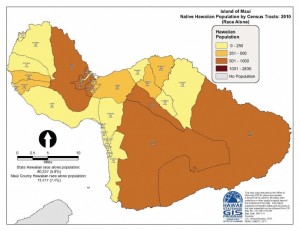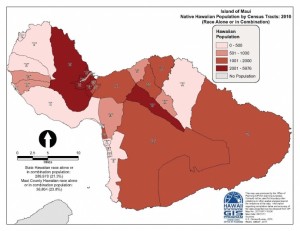Part-Hawaiians Comprise 30% of Maui County Population
By Sonia Isotov
According to a new report on the distribution of the native Hawaiian population in Hawaii, there are 80,337 people in the native Hawaiian “race alone” group in Hawaii.
Native Hawaiians were the fourth largest “race alone” group in Hawaii and comprised about 6% of Hawaii’s resident population in 2010.
In Maui County, native Hawaiians in the “race alone” category comprised 7.4% of the population, and in the “race alone or in combination” group, native Hawaiians comprised 29.7% of the county’s population.
The report, “Native Hawaiian Population by County, Island and Census Tract in the State of Hawaii: 2010”, was produced by the Hawaii State Data Center which is part of the Hawaii State Department of Business, Economic Development & Tourism (DBEDT). This report is the first of the 2010 Census racial group report series being released by DBEDT.
In addition to the “race alone” category, the US Census figures revealed that there were 289,970 responses in the native Hawaiian “race alone or in combination” group. This group was the fourth largest “race alone or in combination” group and made up about 21% of Hawaii’s population.
According to the report, Hawaii County had the largest percentage of native Hawaiian population, followed closely by Kauai County and Maui County, but Oahu had the two census tracts with the largest population of native Hawaiians in the “race alone” or the “race alone or in combination” groups. Census tracts are smaller area geographic designations than a county area.
The category of “race alone” consisted of individuals who chose only that one race. “Race alone or in combination” referred to the number of responses in which an individual chose either that one race or that same race in combination with another race or races.
For example, if an individual chose the race groups of both native Hawaiian and Chinese, that individual’s response would be counted in both the native Hawaiian “race alone or in combination” column as well as the Chinese “race alone or in combination” column. For the native Hawaiian group, this count represented all persons saying they were, for example, either a full or part “native Hawaiian.”
It should be noted that “race alone or in combination” figures refer to number of “responses” and not individuals, so their sum would exceed the total population.
Having statistical information locating where clusters of racial groups currently live in Hawaii may be beneficial to businesses as well as to research organizations or non-profit groups.
Businesses will be able to make more knowledgeable decisions based on where their target population is located or knowing who their customers are in a specific location. Some crucial questions regarding the area may be answered by knowing its demographic characteristics. For example, a certain type of ethnic food may sell much better in one place versus another. Familiarity of cultural practices and sensitivities might add to the success of a business, too.
Other types of organizations may use this data in deciding where they should open an office or how to best serve the majority of their clientele in a particular area. If an area has a significant number of people in a specific racial group, having people who speak their language on the organization’s staff may be helpful. Careful consideration of interactions and customs of families of that racial group may also add to the effectiveness of their staff in delivering services.
The data included was obtained from the US Census Bureau, 2010 Census Summary File 1 and thematic maps included in the report were produced by the Hawaii State Office of Planning’s GIS Program.
The report may be viewed or downloaded from the Hawaii State Department of Business, Economic Development & Tourism’s Internet site at: http://hawaii.gov/dbedt/info/census/Census_2010/SF1/index_html
Census maps (online, thematic and reference) are available on the Hawaii State Office of Planning GIS Program Internet site at: http://hawaii.gov/dbedt/gis/miscmaps.htm











